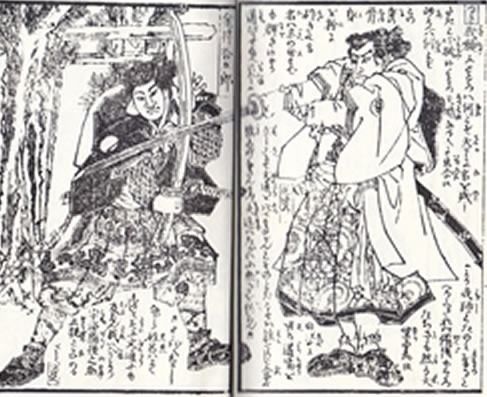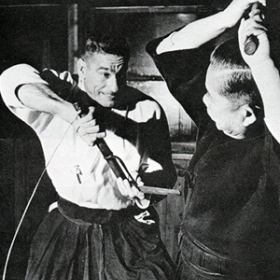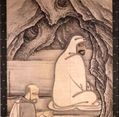|
THE COUP BY YUI SYOSETSU OF 1651Yui Syosetsu’s name appears on a makimono (scroll) for the Isshin Ryu Kusarigamajutsu (sickle & chain art) incorporated into the Shindo Muso Ryu (SMRJ) as the 5th Menkyo (master license) holder. However, it is his successor Isshin Tano for whom the art is named. The Tokugawa purged Yui Syoetsu'sname from history. Indeed his tragic story follows along the same lines as the story of the 47 Ronin - Akoroshi. Throughout the early Edo (Tokugawa government, modern Tokyo) period (1603-1650) Yui Syosetsu’s name was notorious for his coup against the existing Tokugawa Bakufu (military government). He would’ve been considered by the regime as number one on the top ten most wanted criminals of the day by today’s standards.
The Tokugawa administration known for the severe rule it imposed, designed mechanisms to caste a vertical society and to limit the power of the hereditary lords or Daimyo politically, socially and economically. These constraints worked well to control the population and eventually ushered in 3 hundred years of domestic peace. These laws or restrictions were known as the “Buke-Syohatto”[1]. Oppressively strict, violations were treated with absolute consequences and the immediate forfeiture of the Daimyo’s han (domains) regardless of class.[2] Consequently there were large scale social upheavals as local warrior families found themselves without sustenance and unable to support their families. These Ronin (wave men) were not able to simply switch clans and few alternatives other than lawlessness lay open for their survival. It is estimated that the number of these wave men grew to more than 500,000. Yui collected these men and challenged the existing authorities with a coup which ultimately failed when he was betrayed on the eve of the plot.
Yui Shosetsu was teaching Kusunoki Ryu martial strategy in Edo.[3] His lectures were said to be very persuasive and gained popularity. Many ronin (master-less warriors or wave men) became his deshii (students). The Tokugawa Bakufu (military government) recognized this and asked Yui to become an official teacher for the Shogunate. He declined the offer. Yui’s objective was to stop this unpopular Tokugawa policy that in effect was displacing so many warriors. His plan was to steal weapons from the Suruga castle in Shizuoka and also Ieyasu’s (The first Tokugawa Shogun or military leader) inheritance of 2 million goku worth of treasure. The gun powder magazine in Edo (Tokyo) was going to be bombed simultaneously while Edo Castle was occupied and the next Shogun designate, Ietsuna, held hostage while demands be made of the Bakufu (Tokugawa military government) to amend their policies. A similar distraction was planned for Osaka. We’ll never know if Yui’s plan would’ve worked had he not been betrayed. It would seem however that even if his plan had worked perfectly well, his own demise would’ve been part of the deal. He was arrested and committed seppuku (ritual suicide). We can’t interview Yui to understand all of his grievances but the coup itself focused primarily on laws regarding inheritance. The Tokugawa in an effort to consolidate the Daimyo would confiscate properties upon a lord’s death where there was no clear line of succession through a first born son within the household. Yui’s name disgraced throughout the Edo era by the failed coup attempt resulted in a rare reversal of Tokugawa policies. The laws were adjusted to allow the Daimyo to submit prearranged adoption documents for successor in case of death thereby protecting the clan’s succession instead of its destruction.[4] This resulted in protecting the samurai from losing their roles within each of these fiefdoms (han). In looking at the densho (scrolls) of the Shindo Muso Ryu (stick fighting) there are many famous persons that touched Japanese history dramatically. I hope to write about some of these other men soon. [1] Buke: Daimyo Warrior house. Syohatto means laws. Today Japanese colloquialism for “go hatto” means “a social faux paux. [2] 3 Classes: (Tozama (Outside), – literally gaijin, Fudai (inside), and Shinpan (family). [3] It would be interesting to see if this is named after the famous hero Kusunoki Masashge of the 14th century. [4] In effect the laws stayed on the books but enforcement was relaxed allowing for a gray area in which the domain could maneuver in the case of sudden death or the inability to seat a direct male heir.
0 Comments
Your comment will be posted after it is approved.
Leave a Reply. |
AuthorRick Categories
All
Archives
January 2017
|
|
Po Box 232 Severna Park, MD. 21146
|
Copyright © 1996 - 2023




 RSS Feed
RSS Feed






